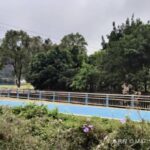Haizhuang Temple is located at No. 337 Tongfu Middle Road, originally constructed during the late Ming and early Qing dynasties, and has a history of over three hundred years. It is a key cultural relics protection unit in Guangzhou city. Known for its solemn appearance, majestic halls, spacious purity, and flourishing Buddhist connections, it is celebrated as one of the five major forests of Guangfu.
The temple is said to have been the ‘Qianqiu Temple’ during the Southern Han era. Over time, it fell into disrepair and became a residential cemetery. In the late Ming Dynasty, it was the property of the wealthy Guo Longyue. Monks Guang Mou and Yue Chi, master and disciple, managed to acquire this land from Guo to build a Buddhist hall. Inspired by the Buddhist scripture where Haizhuang Bhikshu diligently practiced the Prajna Paramita Sutra and attained Buddhahood, they named it ‘Haizhuang Temple’.Haizhuang Temple boasts a long history, a serene environment, and pleasant scenery. The ‘Spring Colors of Haizhuang’ was one of the famous eight scenic spots of the ancient city of Yangcheng. The temple is home to a wealth of historical sites and precious cultural relics, including the Haizhuang Eagle Claw, Sixteen Arhats, Four Great Vajra Beings, Three-mustached Guanyin, Tiger Turning Stone, Haizhuang Palace Tiles, Dan Gui Bowl, Youming Bell, and the Star Stone Pagoda, among many others.

Although Haizhuang Temple has lost the silent, solemn, and mysterious atmosphere of ancient temples, its garden landscape remains unchanged. Here, ancient trees reach for the sky, shaded by greenery, with the river breeze blowing, providing a refreshing experience. In addition to the Eagle Claw Orchid, there are now three ancient Bodhi trees here: one inside the north gate of the temple, another on the southwest side of the Tianwang Hall, and the third behind the Mahavira Hall to the southeast.









